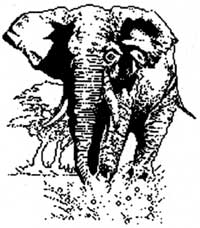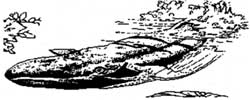
| Letters of the Institute for domestic Tranquility | Washington • September 1989 | Volume 4 • Number 9 |
Elephants and Self-Identification

Similar Life Cycles
The life cycle of an elephant is nearly identical to that of humans. The gestation period is longer, the baby bigger, but the biological development of the elephant tracks the development of humans. They nurse to age three or four. They reach puberty at about age 11. Their reproductive life is until 40 or 50 and their life terminates on the average at age 65. Indian mahouts are chosen at age eleven, to learn to work the elephant whose age is eleven and the pair spend the rest of their lives together. On the death of either one, the other is subject to heavy and emotional mourning. The same as for any loved one.
We have a Lot in common
The elephant is intelligent and has many human behavioral traits, like loyalty, trustworthiness, and engages in altruistic behavior. They live in father absent family groupings led by a dominant female. When the adolescents can not be controlled, which translates to the young bulls, they are driven from the family group and live isolated lives except for the rut which is conducted on the female's terms.
Simply Awesome
I photographed a group of about 150 elephants as they passed before my Volkswagen Microbus on the Ambecelli plain of Kenya. The lead female stopped and the entire group stopped without bumping into each other. She inspected us closely, swinging her head from side to side and moving her trunk first low to the ground then high in the air. Her small set eyes were gazing into our eyes. When she was satisfied that we were harmless she resumed her march. The entire herd followed suit instantaneously and not one other animal so much as gave us a glance. The apparent reason for her caution was a number of new born calves each under the watchful eye of one or more adult females. The very last female again gave us the once over to make sure we were harmless. The sight was of such awesome grandeur that If I had a thousand exposures in my camera I would have shot them all.
Passages
It is a tradition in Japan to give a person a signature scroll when they reach adulthood. The signature scroll has a flat end carved with the name of the individual. It is mounted on a handle of ivory. Japan alone accounts for the consumption of 70% of the ivory coming out of Africa. Thanks to the eight years of Reagan trade deficits and borrowing for defense the Japanese are flush with cash and can afford to buy the ivory.
In her book, The Economic Value of Genetic Resources, Margery Oldfield points out that as species become endangered, the commodity becomes scarce and the price goes up and the harvest intensifies as the price increases hastening the demise of the species. The United States and Europe have declared a moratorium on all ivory imports. Japan has yet to do so.
800 Hundred Tons and What do You Get
According to an article in Science for 9 June 1989, the annual trade in ivory has amounted to a steady 800 tons a year. The poaching took the big animals first so that today it takes three times as many animals to make up the 800 tons of ivory than it did ten years ago. So many males have been killed that females go through estrus without being detected by a male. Since most of the males are gone, the females are now being slaughtered at such a rate as to leave the family grouping in disarray and without leadership. In one Tanzanian population only 15% of the families had leadership in comparison to the usual 75%. Leadership is an adult female. Social disintegration can not but help speed the demise of the elephant.
Mother Nature Knows Best
The highest yield of ivory comes from the natural demise of natural populations. The old bulls yield a great deal of ivory per animal and they don't have to be shot. To allow the populations to recover, the harvest by shooting would have to be drastically reduced, perhaps to zero while the population recovered. Will anyone give the elephant a chance or will we see the harvest increase as the import bans go on, to insure that there will be a good supply of ivory when the ban and scarcity take place.
The World Under Seige
The elephants are being killed by assault weapons. The same as sault weapons used in the drug trade. They work well against DEA agents and the competition. They work well against the park wardens trying to halt the poaching and they work well against the elephant. Perhaps among other things we should quit making assault weapons.
We Need a World Boycott
Nobody should buy elephant ivory until the elephant populations in Africa have recovered. Young adults in Japan must celebrate their adulthood with signature scrolls made from common place materials. A name does not acquire significance because it is carved in ivory and in fact the future Japanese names may acquire great significance because they are not carved in ivory.
In the Name of Dead Elephants
What's in a name? A dead Elephant? Changing the material of the signature scroll is a slight price to pay to save the largest, and one of the most intelligent, land animals on Earth.
. . . Ted Sudia . . .

FOOTNOTE
Japan has yet to agree to limit the catch on whales and has joined other Asiatic countries in the use of drift nets in pelagic fishing. The nets are up to 30 miles long and indiscriminately catch all sea life that gets entangled in them.
© Copyright 1989
Institute for domestic Tranquility
Teach Ecology • Foster Citizenship • Promote Ecological Equity
